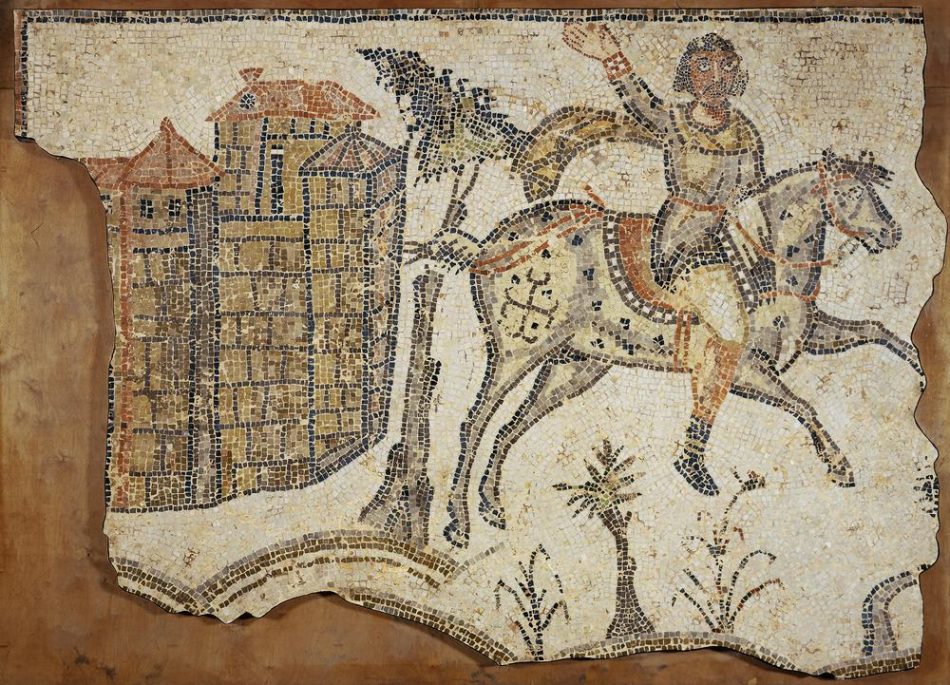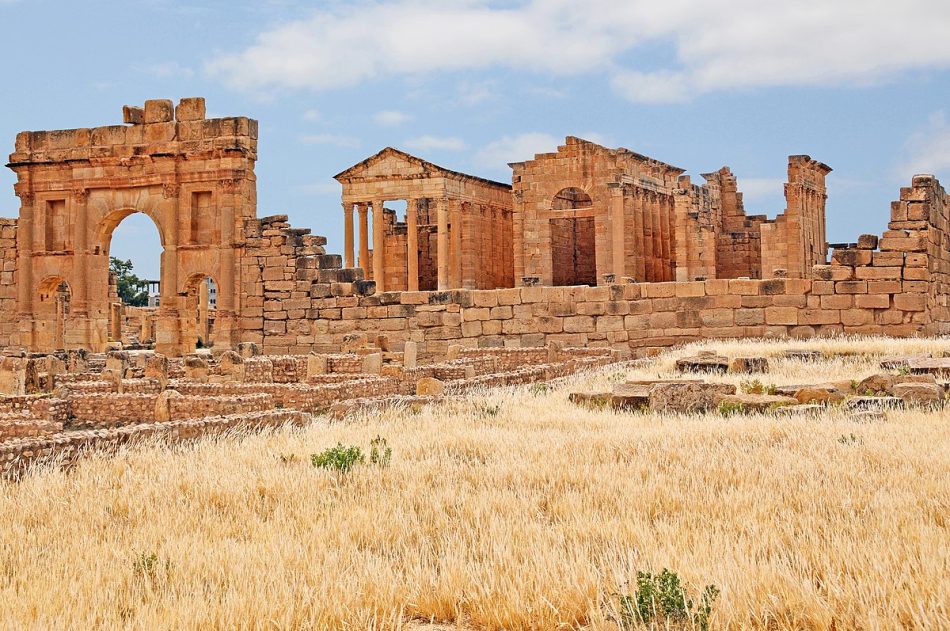The breakout of Diogenes
One of the changes in Roman military organisation between the fourth and sixth centuries AD was the introduction of the bucellarii – privately raised forces who operated as bodyguards for commanders. Their name was derived from their ration of biscuit-like bread, bucellatum, probably similar to hard-tack. These troops were equipped and paid for by the commander himself and bucellarii were probably all heavy cavalry, cataphractarii or perhaps even clibinarii, heavily armoured and armed with lances and swords, although they may have had bows as well.
For his invasion of North Africa in 534, Belisarius had more than 1,000 bucellarii and they achieved remarkable battlefield feats. The anecdote we are going to look at involved one of Belisarius’ bucellarii, Diogenes, who, with only twenty-two companions broke through a force of 300 Vandals who had surrounded them.
The best (sometimes only) source for Belisarius’ campaigns is the historian Procopius of Caesarea in his magisterial work The History of the Wars (the Vandal Wars are in books 3 and 4). Procopius had been the assessor (legal adviser) to Belisarius since 527 and accompanied Belisarius to North Africa. He was thus an eyewitness to the lightning campaign whereby Belisarius conquered all of Vandal North Africa with blistering speed. Procopius seems to have spoken to the bucellarius and his comrades soon after their exploit. He does not, however, use the term bucellarius but refers to the men as "bodyguards" (doryphoroi, literally "spearbearers"), a term he uses very often.

Bucellarii can be seen here on the left (on the emperor Justinian's right hand - the figure assumed to be Belisarius is literally at his right hand)
When Belisarius landed in North Africa in September 534, three months after leaving Constantinople on June 22nd, he made quick progress in his march towards Carthage. It is probable he landed at Cape Vada (modern Ras Kaboudia, Tunisia) and marched approximately 20km each day until he approached Carthage.
Ten miles from the city his cavalry met and defeated the cavalry of the Vandals – the battle was literally fought at a place called Ad Decimum “at the tenth” and Procopius tells us it was seventy stadia (3.17.11) from the city. Note that Procopius here uses seven stadia per Roman mile not the usual eight. This placed the battlefield around the modern Tunis train station of Jebel Jeloud. Thus, much of the battlefield has been swallowed by the modern city. The Vandals fled and Belisarius continued on to take the city of Carthage with ease. A second decisive battle would follow in December at Tricamarum (its exact location remains unknown). Belisarius would thus complete the reconquest of North Africa and topple the vast and feared Vandal empire in less than three months.
Before that decisive encounter, however, he sent his cavalry out to keep an eye on the Vandal king, Gelimer. After his defeat at Ad Decimum, Gelimer had withdrawn to the Plain of Boulla, probably around the area of Bulla Regia, near modern Jendouba, Tunisia. Gelimer's forces were relatively unscathed despite their defeat and Procopius tells us that they numbered 80,000 men (3.5.18) and that they had suffered only 800 casualties at Ad Decimum (Procopius 4.3.18). Now they were to be reinforced by Gelimer’s brother Tzazon, returning from Sardinia with a further 5,000 men. Belisarius, in contrast, had landed with an invasion force of only 15,000 men – 10,000 infantry and 5,000 cavalry. Most modern scholars do not accept Procopius’ exceedingly large number of men for the Vandals – they consider the disparity to be simply too great – especially as they were an all-cavalry army (Procopius 3.8.27). Modern estimates place their number instead anywhere between 20 and 30,000.

Bucellarii bodyguard
Diogenes was sent with only twenty-two men to spy on the whereabouts of the Vandals (Procopius 3.23.5). The small scouting force rode from Carthage for two days when they ran into some local farmers who attempted to cash in on the reward Gelimer was offering for the heads of Belisarius’ men. Unable to kill the bucellarii, the farmer reported their presence to Gelimer who selected 300 of his own cavalry to ride out against them (3.23.7) and to bring them back to the Vandal camp alive.
This overwhelming force of Vandal cavalry arrived where the bucellarii were lodging before dawn. Staying in a two-storey farmhouse overnight, Diogenes and his companions were unaware of the Vandal presence. Since they were charged with taking the small enemy force alive, the Vandals did not assault the farmhouse but encircled it. Procopius accuses the Vandals of cowardice (3.23.11) for not being willing to enter the house in the dark – they could have defeated the men inside easily as they were unprepared, naked and without weapons. Nonetheless, the Vandals encircled the house, making a ring of cavalry – Procopius tells us that they "made a phalanx in a circle about the whole house and especially at the doors, and all took their stand there" (3.23.12).
One of the bucellarii had, however, awoken and had noticed the Vandals; he woke each of his comrades silently and, following instructions from Diogenes, they all dressed as quietly as they could and gathered their weapons, taking them to the lower storey of the farmhouse where their horses were stabled. There, they put their bridles on their horses and mounted. All of this was done without any of the approaching Vandals noticing what was going on inside. Gathering their small number in the courtyard of the farmhouse, they suddenly opened one of the doors and charged in a body straight towards the Vandal force stationed outside at that point. Procopius tells us (3.23.16) that “the Vandals immediately closed with them but they accomplished nothing. For the Romans rode hard, covering themselves with their shields and warding off their assailants with their spears.” Despite being outnumbered 300 to only 22, the Romans broke through the Vandal line, Diogenes leading away twenty of his men, losing only two in the melee.

The Roman ruins of Sbeitla (or Sufetua) in west central Tunisia.
This was clearly only a minor skirmish during the campaign of Belisarius in North Africa, but it is told with remarkable drama by Procopius. It seems clear that Procopius spoke to the men involved; probably Diognes himself, but also some of his troopers – perhaps as Diogenes was recovering in a hospital bed in Carthage after his ordeal. Procopius records the detail that Diogenes received three blows to his neck and face, but also received a blow to his left hand, as a result of which he was thereafter unable to move his little finger. It is a tiny detail but it smacks of verisimilitude and we can see Procopius, sitting at Diognes’ bedside being told of the remarkable deeds of that night – a minor skirmish to be sure, but an exciting one nonetheless.

2 comments
In the assessment of Belisarius, his title is almost always said with Genuis in the same Sentence and so I know he was very incredible yet still, I wonder why the specific word of Genius is attached to him on such a regular basis? The work above is excellent. Another Q is, can someone do an article on what might Belisarius’s Naval ships looked like in his day? How large were they (by now or 800 years after Alexander) and how many horses were transported per ship? What were the different ships of the day for transporting troop movements across water and did by this time, the ships bc of the need for water put in each night and so stayed close to the shore or were they advanced enough to go straight across from Constans to Tunisia in one single sail, stop at Islands? Etc. Thank you for your hard work. gtp
Thanks very much for the article and again shows how well trained these troops were in terms of their ability to operate as heavy horse archers and shock heavy cavalry.